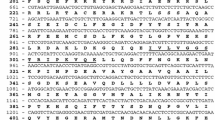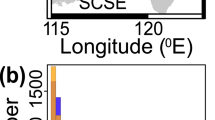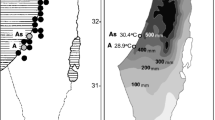Abstract
Phascolosoma esculenta is an intertidal organism that has recently attracted attention because of its ability to survive at relatively low temperatures. However, the gene regulation in P. esculenta in relation to its response to low temperatures is unclear. To explore the low temperature adaptability of P. esculenta, this study analyzed the changes in the morphology and hsp70 and hsp90 gene expression of P. esculenta exposed to a low temperature gradient. At 5°C, P. esculenta stretched and softened, and some individuals moved apart from the group. Histological analysis revealed cuticle breaches, myofiber scattering, disruption of the body wall, and epithelial layer dispersion and muscle fiber rupturing in the nephridium. Furthermore, the mRNA expression levels of hsp70 and hsp90 increased under acute low temperature stress, suggesting that these genes function in low temperature tolerance. Overall, low temperature stress causes morphological changes and histological damage in P. esculenta, and hsp70 and hsp90 potentially function in the low temperature adaptability of P. esculenta. Our results provide new insights into the adaptive strategies of P. esculenta under low temperature environments.
Similar content being viewed by others
References
Adrianov, A. V., and Maiorova, A. S., 2002. Microscopic anatomy and ultrastructure of a Polian wessel in the sipunculan Thysanocardia nigralkeda, 1904 from the sea of Japan. Russian Journal of Marine Biology, 28(2): 100–106.
Ali, K. S., Dorgai, L., Gazdag, A., Abraham, M., and Hermesz, E., 2003. Identification and induction of hsp70 gene by heat shock and cadmium exposure in carp. Acta Biologica Hungarica, 54(3–4): 323–334.
Ansart, A., and Vernon, P., 2003. Cold hardiness in molluscs. Acta Oecologia, 24(2): 95–102.
Bartolomaeus, T., and Quast, B., 2005. Structure and development of nephridia in Annelida and related taxa. Hydrobiologia, 535–536(1): 139–165.
Brun, N. T., Bricelj, V. M., MacRae, T. H., and Ross, N. W., 2008. Heat shock protein responses in thermally stressed bay scallops, Argopecten irradians, and sea scallops, Placopecten ma-gellanicus. Journal of Experimental Marine Biology and Ecology, 358(2): 151–162.
Chen, K., Tang, T., Song, Q., Wang, Z., He, K., Liu, X., Song, J., Wang, L., Yang, Y, and Feng, C., 2019. Transcription analysis of the stress and immune response genes to temperature stress in Ostrinia furnacalis. Frontiers in Physiology, 10: 1289.
Cherkasov, A. S., Ringwood, A. H., and Sokolova, I. M., 2006. Combined effects of temperature acclimation and cadmium exposure on mitochondrial function in eastern oysters Crassostrea virginica Gmelin (Bivalvia: Ostreidae). Environmental Toxicology and Chemistry, 25(9): 2461.
Chiba, S., Iida, T., Tomioka, A., Azuma, N., Kurihara, T., and Tanaka, K., 2016. Population divergence in cold tolerance of the intertidal gastropod Littorina brevicula explained by habitat-specific lowest air temperature. Journal of Experimental Marine Biology and Ecology, 481: 49–56.
Cutler, E. B., 1986. The family Sipunculidae (Sipuncula): Body wall structure and phylogenetic relationships. Bulletin of Marine Science, 38(3): 488–497.
Deng, Z. R., Huang, B., and Fang, Z. G., 2006. Morphological and histological characteristics of body wall in Phscolosoma esculenta. Fisheries Science, 26(6): 335–337 (in Chinese with English abstract).
Feder, M. E., and Hofmann, G. E., 1999. Heat-shock proteins, molecular chaperones, and the stress response: Evolutionary and ecological physiology. Annual Review of Physiology, 61(1): 243–282.
Feng, S., Huang G., Lai, Z., Liang, W., Wu, M., Tang, L., and Pan, Y., 2014. Tolerance studies on the temperature, salinity and desiccation in Perinereis aibuhitensis. Transactions of Oceanology and Limnology, 1: 109–114 (in Chinese with English abstract).
Gao, X. M., Mu, D. L., Hou, C. C., Zhu, J. Q., Jin, S., and Wang, C. L., 2019. Expression and putative functions of KIFC1 for nuclear reshaping and midpiece formation during spermiogenesis of Phascolosoma esculenta. Gene, 683: 169–183.
Helmuth, B., Harley, C. D. G., Halpin, P. M., O’donnell, M., Hofmann, G. E., and Blanchette, C. A., 2002. Climate change and latitudinal patterns of intertidal thermal stress. Science, 298(5595): 1015–1017.
Ji, L., Jiang, K., Liu, M., Wang, B., Han, L., Zhang, M., and Wang, L., 2016. Low temperature stress on the hematological parameters and HSP gene expression in the turbot Scophthalmus maximus. Chinese Journal of Oceanology and Limnology, 34(3): 430–440.
Killen, S. S., Atkinson, D., and Glazier, D. S., 2010. The intras-pecific scaling of metabolic rate with body mass in fishes depends on lifestyle and temperature. Ecology Letters, 13(2): 184–193.
Kim, J. Y., Kim, J. W., and Yenari, M. A., 2019. Heat shock protein signaling in brain ischemia and injury. Neuroscience Letters, 715: 134642.
Li, A. J., Leung, P. T. Y., Bao, V. W. W., Lui, G. C. S., and Leung, K. M. Y., 2015. Temperature-dependent physiological and biochemical responses of the marine medaka Oryzias melastigma with consideration of both low and high thermal extremes. Journal of Thermal Biology, 54: 98–105.
Li, Y. N., and Zhang, H. B., 2018. Progress in antioxidant enzymes study of marine invertebrates. Marine Science Bulletin, 37(3): 241–253 (in Chinese with English abstract).
Liu, C., Shen, W., Hou, C., Gao, X., Wang, Q., Wu, X., and Zhu, J., 2019. Low temperature-induced variation in plasma biochemical indices and aquaglyceroporin gene expression in the large yellow croaker Larimichthys crocea. Scientific Reports, 9: 2717.
Long, L. L., Sheng, Z., Lu, M. M., Ding, L. F., and Zhu, J. Q., 2014. Structural features of musculature in the nephridium of Phascolosoma esculenta. Journal of Biology, 31(2): 9–12.
Loomis, S. H., 1995. Freezing tolerance of marine invertebrates. Oceanography and Marine Biology: An Annual Review, 33: 337–350.
Luo, S. Y., Xu, D. D., Lou, B., Chen, R. Y., Zhan, W., and Mao, G. M., 2017. Effects of low temperature stress on activities of antioxidant enzymes, Na+/-K+-ATP enzyme and Hsp70 content of Nibea albiflora. Marine Science Bulletin, 36(2): 189–194 (in Chinese with English abstract).
Marshall, D. J., McQuaid, C. D., and Williams, G. A., 2010. Non-climatic thermal adaptation: Implications for species’ responses to climate warming. Biology Letters, 6(5): 669–673.
Mathew, A., and Morimoto, R. I., 1998. Role of the heat-shock response in the life and death of proteins. Annals of the New York Academy of Sciences, 851(1): 99–111.
Morimoto, R. I., 1993. Cells in stress: Transcriptional activation of heat shock genes. Science, 259(5100): 1409–1419.
Morimoto, R. I., Kline, M. P., Bimston, D. N., and Cotto, J. J., 1997. The heat-shock response: Regulation and function of heat-shock proteins and molecular chaperones. Essays in Biochemistry, 32: 17–29.
Mu, D. L., Long, L. L., Lu, M. M., Zhu, J. Q., and Ding, L. F., 2013. Morphological features of nephridium in the sipunculan Phascologoma esculenta under light and electron microscopy. Oceanologia et Limnologia Sinica, 44(4): 996–1002 (in Chinese with English abstract).
Ou, Y. J., Liu, Q. Q., Wen, J. F., Li, J. E., and Li, H., 2018. The effects of acute low temperature stress on liver, muscle and gill tissues of juvenile Eleutheronema tetradactylum. Ecological Science, 37(5): 53–59 (in Chinese with English abstract).
Peng, G., Zhao, W., Shi, Z., Chen, H., Liu, Y., Wei, J., and Gao, F., 2016. Cloning HSP70 and HSP90 genes of kaluga (Huso dauricus) and the effects of temperature and salinity stress on their gene expression. Cell Stress and Chaperone, 21: 349–359.
Ran, R., Lu, A., Xu, H., Tang, Y., and Sharp, F. R., 2007. Heat-shock protein regulation of protein folding, protein degradation, protein function and apoptosis. In: Handbook of Neuro-chemistry and Molecular Biology. Springer, New York, 89–107.
Ronges, D., Walsh, J. P., Sinclair, B. J., and Stillman, J. H., 2012. Changes in extreme cold tolerance, membrane composition and cardiac transcriptome during the first day of thermal acclimation in the porcelain crab, Petrolisthes cinctipes. Journal of Experimental Biology, 215(11): 1824–1836.
Somero, G. N., 2010. The physiology of climate change: How potentials for acclimatization and genetic adaptation will determine ‘winners’ and ‘losers’. Journal of Experimental Biology, 213(6): 912–920.
Srivastava, P. K., Menoret, A., Basu, S., Binder, R. J., and Mc-Quade, K. L., 1998. Heat shock proteins come of age: Primitive functions acquire new roles in an adaptive world. Immunity, 8(6): 657–665.
Su, X. R., Du, L. L., Li, Y. Y., Li, Y., Zhou, J., and Li, T. W., 2010. Cloning and expression of HSP70 gene of sipuncula Phascolosoma esculenta. Fish & Shellfish Immunology, 28(3): 461–466.
Wang, Q. F., Shen, W. L., Hou, C. C., Liu, C., Wu, X. F., and Zhu, J. Q., 2017. Physiological responses and changes in gene expression in the large yellow croaker Larimichthys crocea following exposure to hypoxia. Chemosphere, 169: 418–427.
Wegele, H., Müller, L., and Buchner, J., 2004. Hsp70 and Hsp90-a relay team for protein folding. Reviews of Physiology Biochemistry and Pharmacology, 151: 1–44.
Wethey, D. S., Woodin, S. A., Hilbish, T. J., Jones, S. J., Lima, F. P., and Brannock, P. M., 2011. Response of intertidal populations to climate: Effects of extreme events versus long term change. Journal of Experimental Marine Biology and Ecology, 400(1–2): 132–144.
Xu, Y., Zheng, G., Dong, S., Liu, G., and Yu, X., 2014. Molecular cloning, characterization and expression analysis of HSP60, HSP70 and HSP90 in the golden apple snail, Pomacea cana-liculata. Fish & Shellfish Immunology, 41(2): 643–653.
Ying, X. P., Tong, L. L., and Huang, X. L., 2005. The morphological and histological characteristics of digestive tract in Phascolosoma esculenta. Chinese Journal of Zoology, 40(5): 14–20 (in Chinese with English abstract).
Zeng, H., Hong, P., Ding, L., and Zhu, J., 2006. Tolerance of Phascolome esculenta to water temperature and salinity. Fisheries Science, 8(25): 422–423 (in Chinese with English abstract).
Zeng, Z. N., Liu, W. B., Lin, X. Y., Ning, Y., Liu, B., and Ye, J. C., 2010. Study on both temperature and salinity tolerances of the earliest pelagospheric larvae of Sipunculus nudus. Journal of Fujian Fisheries, 1: 14–18 (in Chinese with English abstract).
Zhao, H., Michaelis, M. L., and Blagg, B. S., 2012. Hsp90 modulation for the treatment of Alzheimer’s disease. Advances in Pharmacology, 64: 1–25.
Zhu, J. Q., Wang, W., Xu, S. J., and Zeng, H. X., 2007. Sperma-togenesis and sperm morphology of Phascolosoma esculenta. Acta Zoologica Sinica, 53(4): 733–741.
Acknowledgements
This project was supported by the Ningbo Science and Technology Plan Projects (Nos. 2019B10016, 2016C10004) and the Collaborative Innovation Center for Zhejiang Marine High-Efficiency and Healthy Aquaculture, the K.C. Wong Magna Fund in Ningbo University.
Author information
Authors and Affiliations
Corresponding author
Rights and permissions
About this article
Cite this article
Shen, W., Liu, C., Ni, J. et al. Effects of Low Temperature Stress on the Morphology and hsp70 and hsp90 Gene Expression of Phascolosoma esculenta. J. Ocean Univ. China 20, 159–168 (2021). https://doi.org/10.1007/s11802-021-4475-z
Received:
Revised:
Accepted:
Published:
Issue Date:
DOI: https://doi.org/10.1007/s11802-021-4475-z




